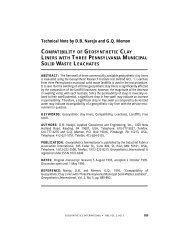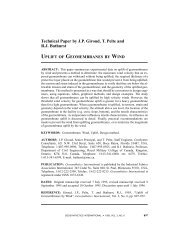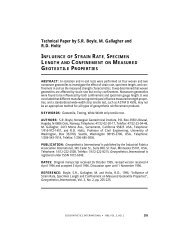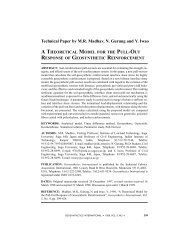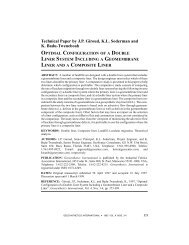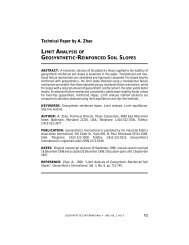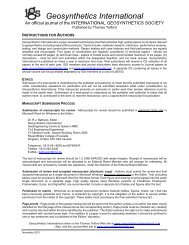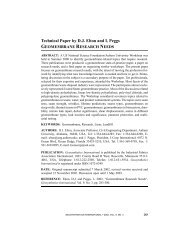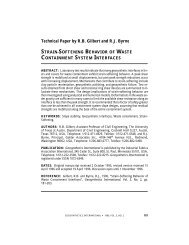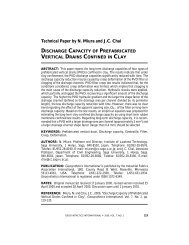Geosynthetics in Railroads - IGS - International Geosynthetics Society
Geosynthetics in Railroads - IGS - International Geosynthetics Society
Geosynthetics in Railroads - IGS - International Geosynthetics Society
Create successful ePaper yourself
Turn your PDF publications into a flip-book with our unique Google optimized e-Paper software.
<strong>Geosynthetics</strong> <strong>in</strong> <strong>Railroads</strong><br />
Prepared by K.C.A. Pimentel, R.J. Bathurst and E.M. Palmeira<br />
<strong>Geosynthetics</strong> may perform the follow<strong>in</strong>g functions <strong>in</strong> new track construction or<br />
rehabilitation: separation of materials with different particle size distributions, filtration,<br />
dra<strong>in</strong>age and soil re<strong>in</strong>forcement. In railroad construction, geosynthetics may be <strong>in</strong>stalled<br />
with<strong>in</strong> or beneath the ballast or subballast layers.<br />
Erosion<br />
Control<br />
703 703<br />
Re<strong>in</strong>forced<br />
Reta<strong>in</strong><strong>in</strong>g Wall<br />
Dra<strong>in</strong>age System<br />
Ballast<br />
Subballast<br />
Subgrade Stabilization<br />
Emphasis will be given here to the use of geosynthetics with<strong>in</strong> and beneath ballast and/or<br />
subballast layers. <strong>Geosynthetics</strong> that are commonly used <strong>in</strong> this application are geotextiles,<br />
geogrids, geocomposites and geocells.<br />
Before<br />
After<br />
Separation: <strong>Geosynthetics</strong> (geotextiles) may be used to separate layers of the track<br />
support structure with different particle sizes and properties. The passage of tra<strong>in</strong>s on the<br />
rail causes movement of the track ties. As a result, f<strong>in</strong>es from the subgrade may be pumped<br />
upward <strong>in</strong>to the granular layers, reduc<strong>in</strong>g the strength and the dra<strong>in</strong>age capacity of these<br />
layers. Furthermore, geosynthetics can reduce the penetration of granular particles <strong>in</strong>to a<br />
soft subgrade, thereby ma<strong>in</strong>ta<strong>in</strong><strong>in</strong>g the thickness and <strong>in</strong>tegrity of the granular layers and<br />
<strong>in</strong>creas<strong>in</strong>g track life time. To provide this function, the geosynthetic must be resistant to<br />
concentrated stresses (tear, puncture and burst) and have aperture sizes compatible with the<br />
particle sizes of the material to be reta<strong>in</strong>ed.
Geosynthetic<br />
Pump<strong>in</strong>g<br />
Separation<br />
Re<strong>in</strong>forcement: <strong>Geosynthetics</strong> (geotextiles, geogrids and<br />
geocells) <strong>in</strong>stalled over unstable subgrades may elim<strong>in</strong>ate the<br />
necessity to replace this soil, <strong>in</strong>creas<strong>in</strong>g the load bear<strong>in</strong>g<br />
capacity of the system due to better stress distribution. When<br />
<strong>in</strong>stalled with<strong>in</strong> the ballast or subballast layers, geosynthetics<br />
may help to reduce settlements associated with the lateral<br />
spread<strong>in</strong>g of the ballast and subballast materials. The ma<strong>in</strong><br />
geosynthetic characteristics that must be considered for this function are the <strong>in</strong>teraction<br />
between geosynthetic-soil/ballast, resistance to mechanical damage, tensile stiffness<br />
modulus and tensile strength.<br />
Filtration: The flow of water from the subgrade <strong>in</strong>to the overly<strong>in</strong>g granular layers may<br />
carry f<strong>in</strong>es from the subgrade. This can occur because of the <strong>in</strong>crease <strong>in</strong> stress levels <strong>in</strong> the<br />
subgrade due to the passage of tra<strong>in</strong>s. In this case, a geotextile can act as a filter, allow<strong>in</strong>g<br />
the water to pass freely while the subgrade solid particles are reta<strong>in</strong>ed. To fulfill this role,<br />
the geotextile must have adequate permeability and retention properties, and be resistant to<br />
clogg<strong>in</strong>g.<br />
Dra<strong>in</strong>age: Good dra<strong>in</strong>age is critically important to avoid track<br />
deterioration due to the action of the water orig<strong>in</strong>at<strong>in</strong>g from<br />
precipitation onto the track or pumped from the subgrade <strong>in</strong>to<br />
the ballast layers. A dra<strong>in</strong>age geocomposite <strong>in</strong>stalled at<br />
relevant po<strong>in</strong>ts <strong>in</strong> the track structure can provide cross-track<br />
dra<strong>in</strong>age, prevent<strong>in</strong>g the accumulation of water. In this<br />
application the geocomposite must have adequate large<br />
discharge capacity and be resistant to mechanical damage.<br />
Ballast<br />
Subballast<br />
Groundwater<br />
If properly specified and <strong>in</strong>stalled, geosynthetics can improve the performance of railroads<br />
by <strong>in</strong>creas<strong>in</strong>g their life time and time between ma<strong>in</strong>tenance cycles.<br />
About the <strong>IGS</strong><br />
The <strong>International</strong> <strong>Geosynthetics</strong> <strong>Society</strong> (<strong>IGS</strong>) is a non-profit organization dedicated to the<br />
scientific and eng<strong>in</strong>eer<strong>in</strong>g development of geotextiles, geomembranes, related products and<br />
associated technologies. The <strong>IGS</strong> promotes the dissem<strong>in</strong>ation of technical <strong>in</strong>formation on<br />
geosynthetics through a newsletter (<strong>IGS</strong> News) and though its two official journals (<strong>Geosynthetics</strong><br />
<strong>International</strong> - www.geosynthetics-<strong>in</strong>ternational.com and Geotextiles and Geomembranes -<br />
www.elsevier.com/locate/geotexmem). Additional <strong>in</strong>formation on the <strong>IGS</strong> and its activities can be<br />
obta<strong>in</strong>ed at www.geosyntheticssociety.org or contact<strong>in</strong>g the <strong>IGS</strong> Secretariat at <strong>IGS</strong>sec@aol.com<br />
Disclaimer: The <strong>in</strong>formation presented <strong>in</strong> this document has been reviewed by the Education Committee of<br />
the <strong>International</strong> <strong>Geosynthetics</strong> <strong>Society</strong> and is believed to fairly represent the current state of practice.<br />
However, the <strong>International</strong> <strong>Geosynthetics</strong> <strong>Society</strong> does not accept any liability aris<strong>in</strong>g <strong>in</strong> any way from use<br />
of the <strong>in</strong>formation presented. Reproduction of this material is permitted if the source is clearly stated.



